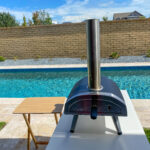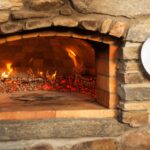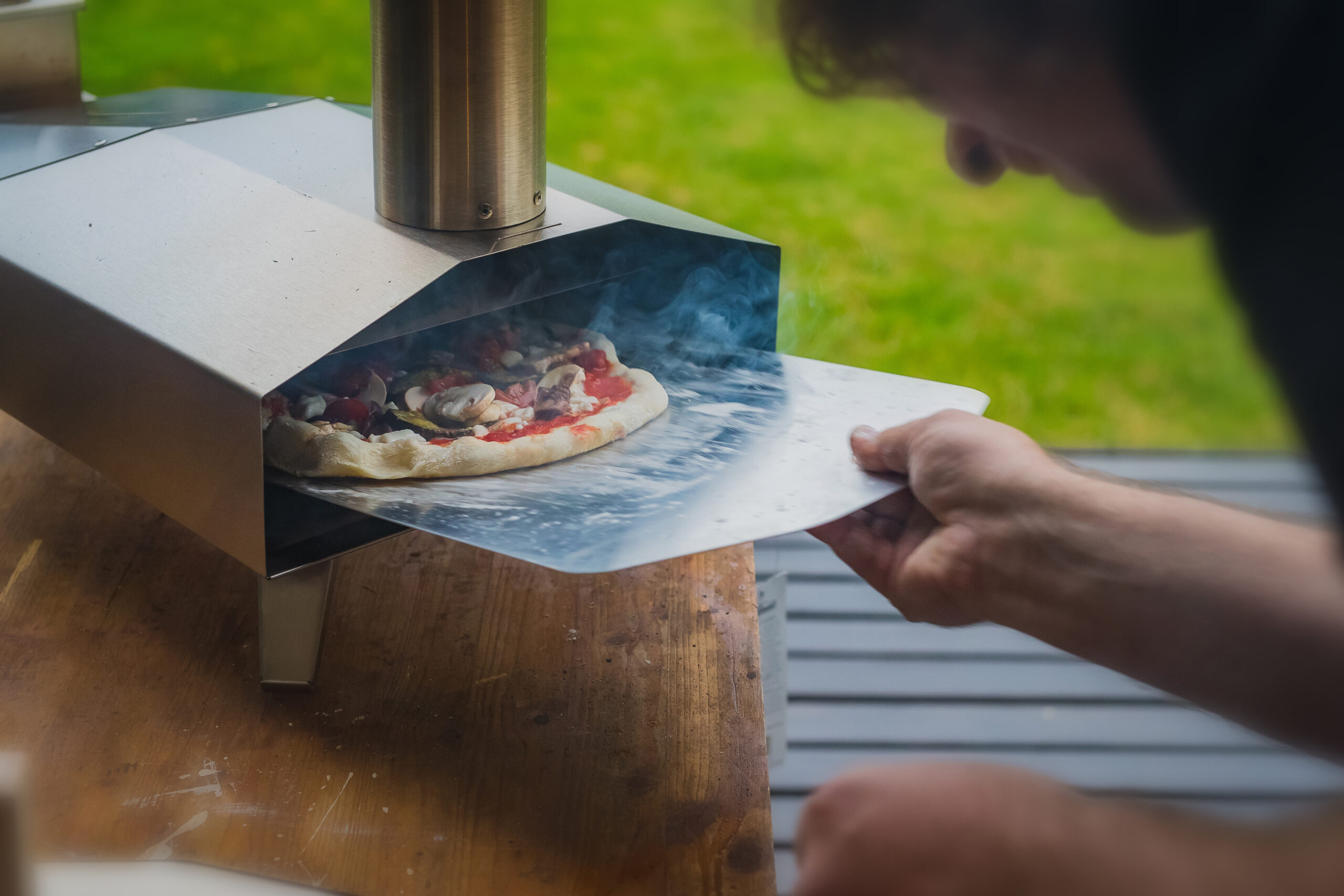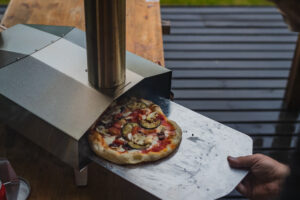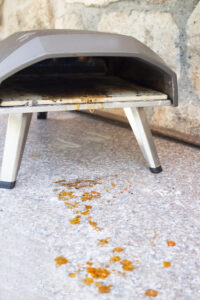A gas pizza oven is a popular choice for many pizzerias and home chefs alike. It is an efficient way to cook a delicious pizza quickly and evenly. But how does a gas pizza oven work? Understanding the basics of how a gas pizza oven operates can help you achieve the perfect pizza every time.
A gas pizza oven uses a combination of gas heat from a gas burner and radiant heat from the oven walls to cook pizza. The gas burner is used to heat the oven, and the heat is reflected off the dome-shaped walls, creating an even temperature throughout the cooking process. The oven’s heat source is controlled by a thermostat, which allows you to adjust the temperature to suit your needs. Some gas pizza ovens also have a convection fan, which circulates the hot air inside the oven, ensuring that the pizza is cooked evenly from top to bottom.
Overall, a gas pizza oven is a reliable and efficient way to cook a delicious pizza. By understanding how it works, you can make the most of this versatile cooking appliance and enjoy perfect pizzas every time.
Fundamentals of a Gas Pizza Oven
A gas pizza oven is an efficient way to cook delicious pizza. It uses a combination of gas heat from a gas burner and radiant heat from the oven walls to cook pizza. Understanding the basics of a gas pizza oven can help you make the most of your appliance and cook delicious pizza every time.
Gas Supply
The gas supply is a critical component of a gas pizza oven. The oven needs a steady supply of gas to heat up and cook the pizza. Most gas pizza ovens use natural gas or propane as a fuel source. Natural gas is usually supplied to the oven through a gas line, while propane is supplied through a propane tank.
It is important to ensure that the gas supply is properly connected and regulated. The oven should have a pressure regulator to ensure that the gas pressure is at the correct level. The gas supply should also be turned off when the oven is not in use to prevent leaks.
Ignition System
The ignition system is responsible for lighting the gas burner and starting the cooking process. Most gas pizza ovens use an electronic ignition system that creates a spark to ignite the gas. Some ovens may also have a pilot light that stays on continuously to ensure that the oven is always ready to use.
It is important to ensure that the ignition system is working properly before using the oven. If the ignition system is not working, the oven will not heat up and the pizza will not cook properly. Regular maintenance and cleaning of the ignition system can help ensure that it is working properly.
In summary, a gas pizza oven uses a combination of gas heat and radiant heat to cook delicious pizza. Understanding the fundamentals of a gas pizza oven, including the gas supply and ignition system, can help you make the most of your appliance and cook delicious pizza every time.
Heat Distribution in a Gas Pizza Oven
When it comes to cooking a perfect pizza, heat distribution is crucial. A gas pizza oven uses a combination of convection, radiation, and conduction to cook the pizza evenly and quickly.
Convection
Convection is the transfer of heat through a fluid, such as air or steam. In a gas pizza oven, the heat is created by the gas burners at the bottom of the oven. The hot air rises and circulates around the oven, cooking the pizza from all sides. This method of heat transfer is called convection heating.
Radiation
Radiation is the transfer of heat through electromagnetic waves, such as infrared radiation. In a gas pizza oven, the heat radiates from the oven walls and ceiling onto the pizza, cooking it from the top. This method of heat transfer is called radiant heating.
Conduction
Conduction is the transfer of heat through direct contact. In a gas pizza oven, the pizza is placed directly on the hot surface of the oven, which is usually made of stone or metal. The heat is conducted from the oven surface to the pizza, cooking it from the bottom. This method of heat transfer is called conductive heating.
To ensure even heat distribution, gas pizza ovens usually have a ventilation system that helps circulate the hot air around the oven. This helps to prevent hot spots and ensures that the pizza is cooked evenly.
In conclusion, a gas pizza oven uses a combination of convection, radiation, and conduction to cook the pizza evenly and quickly. By understanding how heat is distributed in a gas pizza oven, you can ensure that your pizza is cooked to perfection every time.
Temperature Control in a Gas Pizza Oven
A gas pizza oven uses a combination of gas heat from a gas burner and radiant heat from the oven walls to cook pizza. The gas burner is used to heat the oven and the heat is reflected off the dome-shaped walls, creating an even temperature throughout the cooking process. Temperature control is critical in ensuring that the pizza is cooked to perfection, with a crispy crust and melted cheese.
Thermostat
The thermostat is a device that controls the temperature of the gas pizza oven. It is an essential component of the oven, as it regulates the temperature to the desired level. The thermostat is usually located at the front of the oven and can be adjusted to the desired temperature. Once the desired temperature is set, the thermostat will automatically turn the gas burner on and off to maintain the temperature.
Gas Regulator
The gas regulator is another critical component of the gas pizza oven. It controls the flow of gas to the burner and regulates the pressure of the gas. The gas regulator ensures that the gas is delivered to the burner at a consistent pressure, which is necessary for even cooking. If the pressure is too low, the pizza will not cook properly, and if the pressure is too high, it can damage the oven.
In summary, temperature control is crucial in a gas pizza oven, and the thermostat and gas regulator are essential components that ensure the oven maintains the desired temperature and cooks the pizza evenly. By understanding how these components work, you can ensure that your pizza is cooked to perfection every time.
Maintenance of a Gas Pizza Oven
Proper maintenance of a gas pizza oven is crucial to ensure its longevity and optimal performance. This section will cover the three main aspects of maintaining a gas pizza oven: cleaning, inspection, and repair.
Cleaning
Regular cleaning of a gas pizza oven is essential to prevent the build-up of grease and other debris that can compromise the oven’s performance. Here are some tips for cleaning a gas pizza oven:
- Always wait for the oven to cool down before cleaning it.
- Use a soft-bristled brush to remove any loose debris from the oven.
- Wipe the oven walls and floor with a damp cloth or sponge.
- Use a mild detergent to clean any stubborn stains or grease.
- Rinse the oven thoroughly with clean water and dry it with a clean towel.
It is recommended to clean the oven after every use to prevent the build-up of grease and other debris.
Inspection
Regular inspection of a gas pizza oven is necessary to identify any potential issues before they turn into major problems. Here are some things to inspect:
- Check the oven’s burners for any signs of damage or wear.
- Inspect the oven’s gas lines for any leaks or damage.
- Examine the oven’s door gasket for any cracks or tears.
- Check the oven’s pilot light to ensure it is functioning correctly.
It is recommended to inspect the oven at least once a month to identify any potential issues.
Repair
If any issues are identified during the inspection, it is essential to address them promptly to prevent further damage to the oven. Here are some common repairs that may be necessary:
- Replace any damaged or worn burners.
- Repair any leaks or damage to the gas lines.
- Replace any cracked or torn door gaskets.
- Repair or replace any malfunctioning pilot lights.
It is recommended to have a professional technician perform any necessary repairs to ensure the oven’s safety and optimal performance.
In conclusion, regular cleaning, inspection, and repair of a gas pizza oven are essential to ensure its longevity and optimal performance. By following these maintenance tips, you can keep your gas pizza oven in top condition for years to come.
Advantages and Disadvantages of a Gas Pizza Oven
Gas pizza ovens are a popular choice for pizzerias and restaurants due to their numerous advantages. However, they also have some disadvantages that should be considered.
Efficiency
One of the main advantages of a gas pizza oven is its efficiency. Gas ovens heat up quickly and maintain a consistent temperature, which means that pizzas can be cooked faster and more efficiently than with other types of ovens. Additionally, gas ovens tend to be more energy-efficient than their electric counterparts, which can save money on energy bills in the long run.
Flavor
While gas ovens are efficient, they may not produce the same flavor as wood-fired ovens. Wood-fired ovens create a smoky, charred flavor that is difficult to replicate with gas ovens. However, some gas ovens are designed to mimic the flavor of wood-fired ovens by using wood chips or other flavor enhancers.
Cost
Gas ovens tend to be less expensive than wood-fired ovens, making them a more affordable option for many pizzerias and restaurants. Additionally, gas ovens require less maintenance than wood-fired ovens, which can save money on repairs and upkeep.
However, there are some disadvantages to using gas ovens. For example, gas ovens require a gas line to be installed, which can be costly. Additionally, some people believe that gas ovens do not produce the same quality of pizza crust as wood-fired ovens.
Overall, gas pizza ovens are a great choice for pizzerias and restaurants that are looking for an efficient, affordable option. While they may not produce the same flavor as wood-fired ovens, their efficiency and cost-effectiveness make them a popular choice for many businesses.


